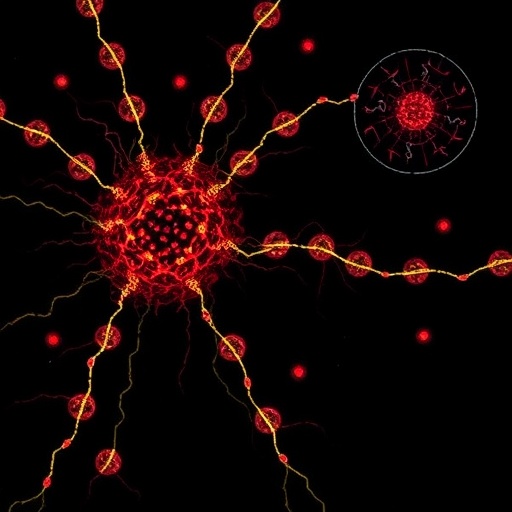In a groundbreaking study recently published in Cell Death Discovery, scientists have unveiled a novel mechanism by which β-catenin facilitates cell survival during the critical process of primitive streak induction in human embryonic stem cells (hESCs). This discovery challenges the longstanding paradigm that β-catenin’s role is primarily centered around its transcriptional activity within the canonical Wnt signaling pathway. Instead, Zhang, Li, Bai, and colleagues demonstrate that β-catenin exerts a transcription-independent function crucial for safeguarding cells as they embark on the earliest steps of embryonic development.
During embryogenesis, the primitive streak represents a pivotal structure that sets the stage for gastrulation—a phase where the three primary germ layers are formed. Gastrulation is central to establishing the body plan; thus, any disruptions during primitive streak induction can have profound consequences on embryonic viability and proper development. Human embryonic stem cells, owing to their pluripotency and capability to differentiate into all cell types, serve as an invaluable model for studying these early developmental stages in vitro.
Investigators have long recognized β-catenin as a multifunctional protein, most renowned for its dual role in cell adhesion and as a mediator of gene transcription within the Wnt pathway. Canonically, Wnt signals stabilize β-catenin in the cytoplasm, allowing its translocation into the nucleus where it influences gene expression patterns that guide cell fate decisions. However, recent evidence, including this latest study, indicates a more complex functionality for β-catenin, especially during the tightly regulated process of human primitive streak induction.
The researchers utilized advanced stem cell culture techniques and precise molecular manipulations to delineate the role of β-catenin during the induction of the primitive streak stage from hESCs. Employing genome editing tools, pharmacological inhibitors, and state-of-the-art imaging platforms, they observed that β-catenin maintains cell viability independent of its transcriptional activity. Surprisingly, β-catenin was found to engage directly in cytoplasmic and membrane-associated processes that prevent apoptotic signals during this critical developmental window.
One of the most striking findings from the study was the decoupling of β-catenin’s transcriptional activity from its cell survival role. By using mutants of β-catenin that specifically abolish its nuclear localization and transcriptional co-activator functions, researchers discovered that the cells still maintained survival during primitive streak formation. This indicates that alternative β-catenin-driven pathways play protective roles, suggesting that the protein’s function in the embryonic context is far more versatile than previously understood.
Further molecular investigations revealed that β-catenin modulates the dynamics of cell-cell junctions and ionic homeostasis in ways that fortify cells against intrinsic stress signals. These cytoplasmic functions are vital during the transition of hESCs toward a primitive streak fate, a process inherently accompanied by considerable cellular remodeling and susceptibility to programmed cell death. The ability of β-catenin to maintain membrane integrity and prevent activation of intrinsic apoptotic pathways underscores its multifaceted nature during early human development.
Moreover, the study sheds light on how β-catenin’s non-transcriptional activities intersect with known survival signaling cascades such as those regulated by kinases and phosphatases. The authors propose that β-catenin acts as a scaffolding molecule, recruiting essential signaling partners to cellular junctions to coordinate survival signals efficiently. This insight opens the door to understanding complex networks where traditional signaling roles and structural functions converge, particularly within stem cells embarking on differentiation trajectories.
These findings hold profound implications not only for developmental biology but also for regenerative medicine and disease modeling. Harnessing the protective, transcription-independent functions of β-catenin could pave the way for novel strategies to enhance stem cell survival during differentiation protocols, which remain a bottleneck in generating specific cell populations for therapeutic use. Additionally, understanding how β-catenin maintains cell survival without influencing gene expression reshapes our approach to targeting this protein in pathological conditions, including cancers and degenerative diseases.
Crucially, the study’s temporal precision in mapping β-catenin’s role during primitive streak induction provides a framework for dissecting other stage-specific functions of key developmental proteins. This research emphasizes that timing and cellular context are critical when interpreting protein functions, especially in dynamic processes such as embryonic differentiation and morphogenesis. β-catenin’s transcription-independent safeguarding role may represent only one facet of a wider repertoire of mechanisms ensuring embryonic success.
Future research stemming from these findings could investigate the biochemical nature of β-catenin’s interactions at the membrane and cytoplasmic levels during primitive streak advancement. Additionally, it will be essential to explore whether similar non-transcriptional roles are mirrored in other stem cell types and developmental phases, enhancing our understanding of protein multifunctionality across biological systems. The potential to uncouple β-catenin’s gene regulatory functions from its survival roles may also inform the development of more selective therapeutics targeting aberrant β-catenin in cancer without compromising normal cellular health.
In conclusion, Zhang and colleagues provide compelling evidence that β-catenin’s role during the induction of the primitive streak from human embryonic stem cells transcends classical transcriptional regulation. By operating through a transcription-independent mechanism, β-catenin acts as a guardian of cell survival during one of the most fragile and formative phases of human development. This paradigm-shifting discovery elevates our knowledge of embryogenesis and positions β-catenin as a vital multifunctional protein whose full range of activity is only beginning to be uncovered.
Their work not only challenges textbook dogma but also presents exciting new avenues for biomedical research, with possible ramifications for stem cell biology, developmental disorders, and innovative regenerative therapies. As we continue to decipher the intricate molecular choreography of early human development, insights like these remind us of the delicate balancing acts performed by cellular components, ensuring life’s progression from a single pluripotent cell toward a complex multicellular organism.
Subject of Research: β-catenin’s transcription-independent role in safeguarding cell survival during primitive streak induction from human embryonic stem cells.
Article Title: β-catenin safeguards cell survival via a transcription-independent mechanism during the induction of primitive streak from hESCs.
Article References: Zhang, P., Li, XX., Bai, HJ. et al. β-catenin safeguards cell survival via a transcription-independent mechanism during the induction of primitive streak from hESCs. Cell Death Discov. 11, 300 (2025). https://doi.org/10.1038/s41420-025-02559-w
Image Credits: AI Generated




